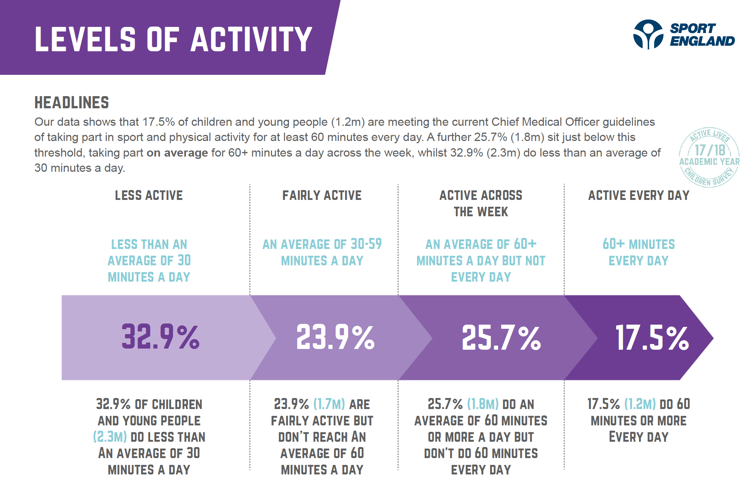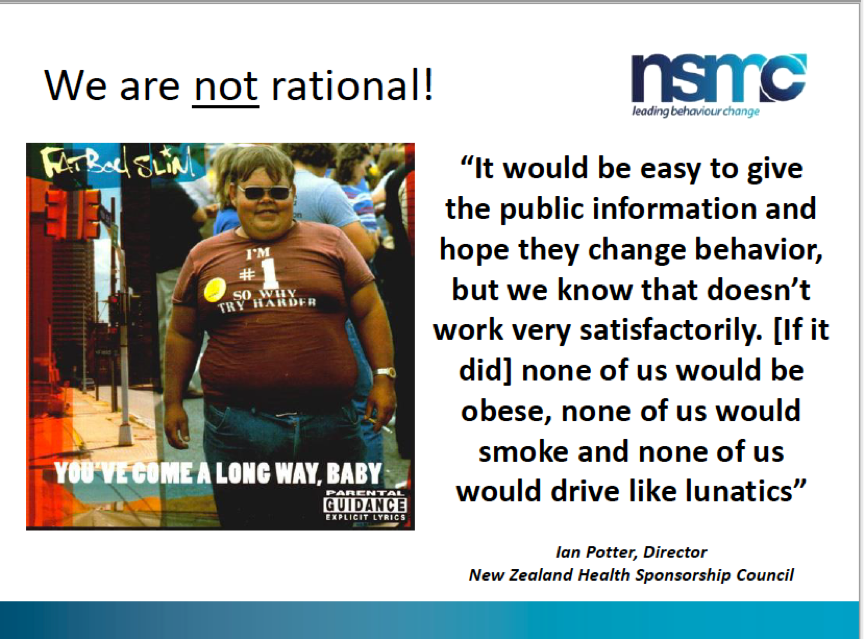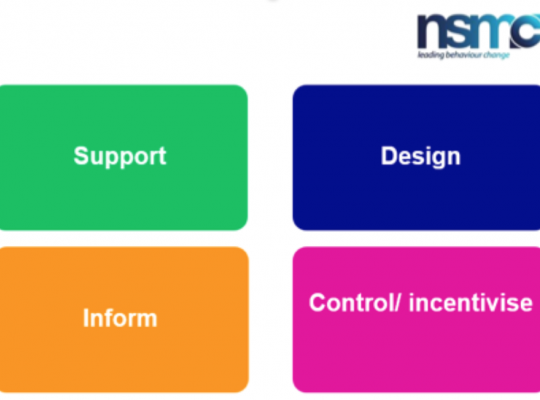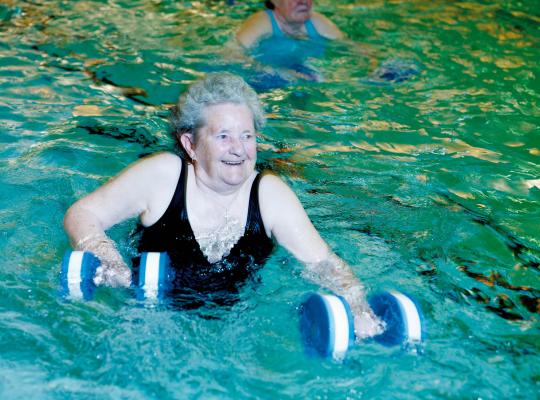Article written by Rowena Merritt, Director, National Centre of Social Marketing
Starting your social marketing project: Identifying the target behaviour and setting behaviour goals.
Social marketing is all about achieving sustainable behaviour change. Unfortunately, our population is around 20% less active than in the 1960s. If current trends continue, it is predicted that we will be 35% less active by 2030[1]. The recent Sport England’s Active Lives Children and Young People Survey showed that around 3 million children (43.3%) lead active lives, however of that group, only 1.2 million (17.5%) are meeting the Chief Medical Officer’s guidelines of more than the recommend exercise of one hour per day, every day of the week.
These figures highlight the importance of ensuring that any behaviour change work achieves long-term behaviour change rather than just short-term change that later lapses.

Understanding what a behaviour is
As mentioned above, social marketing is not simply about changing attitudes or increasing knowledge, it is about achieving a sustainable behaviour change. To understand this better, let’s define more precisely what we mean by a behaviour. At the NSMC we say that a behaviour should be:
- An action
- Observable
- Specific
- Measurable
- Feasible
- Improve outcomes
Which of these would be a behaviour?
I want my audience to:
- be aware of….
- understand the value of…
- call a hotline number
- believe that an advert is true
- support the idea of
- join a group
Three and six are actions, which are clearly observed and can be measured – they are your behaviours. On the whole, they sound feasible, but from the information given above, we cannot tell for sure. For example, calling a hotline would not be feasible in the rural parts of Ethiopia where I currently work as very few people have phones. Considering the feasibility of the behaviour and whether what you are asking people to do is also important and is discussed in more detail later on in this blog post.
Being clear on what you want people to do
Setting a behavioural goal is fundamental to any social marketing project. However, as discussed to be able to do this, you have to be clear on the behaviour you want people to do and how often you want them to do it. If you are not clear about it, how can you expect your target audience to understand what you are asking them to do?
The UK Chief Medical Officers publish guidelines in relation to the level of physical activity that certain age groups should be doing. For example, current guidelines for physical activity for children and young people (5-18 years) is at least 60 minutes everyday. The guidelines also state: “include muscle and bone strengthening activities 3 times per week”.
I have worked in public health for nearly 20 years and as a mother of a six-year-old, I am unsure what exercise would be classed as “muscle and bone strengthening”. This confusion could hinder the desired behaviour change as other parents may, like I am, be unsure on what the guidelines actually mean in practice.
It is also important to recognise there are also often multi behaviours that need to be changed for each problem we are trying address, and for each of the different behaviours, there will be different barriers and benefits, so we need to look at the behaviours separately. For example, if I was doing a project to tackle obesity in school children, some of the behaviours I might identify as important could include:
- consumption of sugary snacks
- screen time
- physical activity
- consumption of fizzy drinks
- consumption of fast food/takeaways
It is difficult as sometimes you want to tackle all these issues in one go, but realistically, that is too difficult to do. that is why you need to focus on one behaviour at a time. When selecting the behaviour, it is important to reflect on what impact it will have and what is the likelihood of you being able to influence the desired behaviour. You may find it useful to plot ideas on the graph illustrated below.

Being SMART
Once you have agreed upon the desired behaviour change, you then set SMART behavioural objectives. “SMART” is an acronym and stands for:
• Specific • Measurable • Achievable • Relevant • Time-specific
An example of a SMART objective would be:
Increase the number of 13-15 year-old secondary school students who attend an after school sports clubs once a week from 5% in 2018 to 8% by the end of 2019.
As the “A” in SMART states, you have to consider whether or not your behavioural goal is realistic. If someone is currently not active at all, it is probably not realistic to expect them to do one hour per day straight away.
To set a SMART objective you need to be clear on who your target audience is, e.g. if you are looking to change children’s behaviours who do you need to target is it the children? parents? teachers? It is not always the people you first identified when you began your research. About 10 years ago I started working on a project to increase school meal uptake in a very deprived part of England. It was just after the Jamie Oliver school meals TV programme and although school meals were now healthier, the uptake was extremely low. In the schools I was working in, even those who were eligible for free school meals were still opting to bring in pack lunches. At first I thought I would focus on the children themselves and they would be my primary target audience. The children we aged 7-11 years old and research showed me that by this age, the kids were starting to have more say in what they would (and would not!) eat.
However, I realised pretty quickly that I could not reach these children – I couldn’t just go into a school and chat to them. I then considered the parents, but I had the same issue, how would I reach them? I didn’t fancy just hanging around the school gates at drop-off and pick-up time! I then started to talk to the Head Teachers and I quickly recognised a pattern; if the Head Teachers were positive about school meals and actively promoted them, their school had a much high uptake. The Head Teachers were also the gatekeepers to both the children and the parents. Therefore, my primary target audience became the Head Teachers.
Realistic Expectations
You should not set a goal that is too ambitious or broad for your target audience, as it only makes the task seem unmanageable and can raise stakeholders and managers expectations on what is actually achievable. By having realistic goals and expectations, you are also more likely to motivate your target audience to succeed. They can understand exactly what they have to do to achieve their goal, and (most importantly) they believe that they can achieve it.

Therefore, when setting your SMART behavioural objectives, look at the existing evidence base, draw on any research reports that are out there and consider what is a realistic objective and what would motivate your target audience to change their behaviour.
Once the desired behaviour change has been selected, SMART behavioural objectives set and targets audiences identified the social marketing plan can be written. This plan is informed by formative research with your target audience. It is important to remember at this point that people are not rational and just giving them knowledge is unlikely to change behaviour. Social marketing makes things fun, easy (more convenient) and popular, aiming to make the behaviour the desire social norm. We need to ‘sell’ the benefits of the new behaviour in relation to lifestyle, feelings and emotions, not just facts and figures. Ideas to help discuss interventions will be discussed in future blogs.

Take a flexible approach
Finally, be flexible in your approach to setting a project’s behavioural objectives. Regularly review them and keep a record of any changes made to them and why these were necessary. Behaviour is dynamic and motivations and benefits valued by the target audience may change so it is important the project adapts.
[1]Public Health England. Guidance Physical activity: applying All Our Health. Available online: https://www.gov.uk/government/publications/physical-activity-applying-all-our-health/physical-activity-applying-all-our-health Accessed 6thDecember 2018


